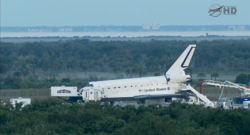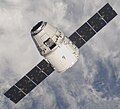User:Craigboy/Space Shuttle successors
Former planned Space Shuttle successors
[edit]
In the 1980s and 1990s, one of the planned successors to STS was called "Shuttle II". At one point before retirement, extension of the Space Shuttle program for an additional five years while a replacement can be developed, was considered by the U.S. government.[1]
For comparison to an earlier retirement, when the Saturn IB was last flown in 1975 for the Apollo-Soyuz Test Project, the Shuttle development program was already well underway. However, the Shuttle did not fly until 1981, which left a six year gap in U.S. manned spaceflight. Because of this and other reasons, the U.S. space station Skylab burned up in the atmosphere.[2]
Constellation Program
[edit]Following the destruction of Space Shuttle Columbia, in early 2004 then President George W. Bush, announced his Vision for Space Exploration which called for the completion of the American portion of the International Space Station by 2010 (due to delays this would not happen until 2011), the retirement of the Space Shuttle fleet following its completion, to return to the moon by 2020 and one day to Mars.[3] A new vehicle would need be developed, it eventually was named the Orion spacecraft, a six person variant would have serviced the ISS and a four person variant would have traveled to the Moon. The Ares I would have launched Orion and the heavy-lift vehicle (HLV), the Ares V would have launched all other hardware. The Altair lunar lander would have landed crew and cargo onto the moon. The Constellation program experienced many cost overruns and schedule delays.[4][5]
In February 2010, President Barack Obama's administration proposed eliminating public funds for the Constellation program and shifting greater responsibility of servicing the ISS to private companies.[6] During speech at the Kennedy Space Center on April 15th, 2010, Obama proposed the design selection of the new HLV that would replace the Ares-V would not occur until 2015.[7] The U.S. Congress drafted the NASA Authorization Act of 2010 and President Obama signed it into law on October 11th of that year.[8] The authorization act officially canceled the Constellation program.[8]
Current and future Space Shuttle successors
[edit]Beyond Low Earth Orbit
[edit]
The NASA Authorization Act of 2010 required a new heavy lift vehicle design to be chosen within 90 days of its passing.[9] The authorization act called this new HLV the Space Launch System (SLS). The Orion spacecraft was left virtually unchanged from its previous design. The Space Launch System will launch both Orion and other necessary hardware.[10] The SLS is to be upgraded over time with more powerful versions. The initial capability of SLS is required to be able to lift 70 mt into LEO, it is then panned to be upgraded to 105 mt and then eventually to 130 mt.[11][12]
Exploration Flight Test-1 (EFT-1), an unmanned test flight of Orion's crew module, is planned to be launched in 2014 on a Delta IV Heavy rocket.[12] Exploration Mission-1 (EM-1) is the unmanned initial launch of SLS, which is planned for 2017.[12] The first manned flight of Orion and SLS, Exploration Mission-2 (EM-2) is to launch between 2019 and 2021; it is a 10-14 day mission planned to place a crew of four into Lunar orbit.[12] As of March 2012, the destination for EM-3 and the remainder of the focus for this new program is still in-flux.[13]
ISS crew and cargo resupply
[edit]The ISS is planned to be funded until at least 2020.[14] There has been discussion to extend it to 2028 and possibly beyond that.[15] Until another US manned spacecraft is ready, crews will travel to and from the International Space Station exclusively aboard the Russian Soyuz spacecraft.[16]
Commercial Resupply Services
[edit]The Commercial Orbital Transportation Services (COTS) development program began in 2006 with the purpose of creating commercially operated unmanned cargo vehicles to service the ISS.[17] The program is a fixed price milestone-based development program, meaning that each company that received a funded award had have a list of milestones with a dollar value attached to them that they didn't receive until after they had successful completed the milestone.[18] Private companies are also required to have some "skin in the game" which refers raising an unspecified amount of private investment for their proposal.[19]
On 23 December 2008, NASA awarded Commercial Resupply Services contracts to SpaceX and Orbital Sciences Corporation.[20] SpaceX will use its Falcon 9 rocket and Dragon spacecraft.[21] Orbital Sciences will use its Antares rocket and Cygnus spacecraft. The first Dragon resupply mission occurred in May 2012.[22] The first Cygnus resupply mission is expected to occur in late 2012.[23] The CRS program provides for all America's ISS cargo needs; with the exception of a few vehicle-specific payloads that are delivered on the European ATV and the Japanese HTV.[24]
-
The Dragon is seen being berthed to the ISS
-
Artist's rendering of the Enhanced variant of Cygnus
Commercial Crew Program
[edit]The Commercial Crew Development (CCDev) program was initiated in 2010 with the purpose of creating commercially operated manned spacecraft capable of delivering at least four crew members to the ISS, staying docked for 180 days and then returning them back to Earth.[25][26] Like COTS, CCDev is also a fixed price milestone-based developmental program that requires some private investment.[18]
In the first phase of the program, NASA provided a total of $50 million divided among five American companies, intended to foster research and development into human spaceflight concepts and technologies in the private sector. In 2011, during the second phase of the program, NASA provided $270 million divided among four companies.[27] The winners of the latest round were SpaceX's Dragon, Boeing's CST-100, Blue Origin's Space Vehicle and Sierra Nevada's Dream Chaser.[28] The United Launch Alliance is working on human-rating their Atlas V rocket as part of the latter three proposals. NASA wants to have two Commercial Crew vehicles in service, these spacecraft are expected to begin delivering crew around 2017.[29][30]
-
The unmanned variant of Dragon is seen approaching the ISS
-
Computer rendering of CST-100 in orbit
-
Computer rendering of Blue Orgin's Space Vehicle
-
CG rendering of DreamChaser docked to the ISS
References
[edit]- ^ Cite error: The named reference
Orlando Sentinelwas invoked but never defined (see the help page). - ^ Edelson, Edward. "Saving Skylab: The untold story" Popular Science, January 1979.
- ^ Bush, George (2004-01-14). "President Bush Announces New Vision for Space Exploration Program". Retrieved 3 March 2012.
- ^ Atkinson, Nancy (2008-07-17). "Problems Surface For Constellation Program". Universe Today. Retrieved 3 March 2012.
- ^ "Review of U.S. Human Spaceflight Plans Committee". NASA. 2009-10-22. Retrieved 3 March 2012.
- ^ Cite error: The named reference
Achenbachwas invoked but never defined (see the help page). - ^ "President Barack Obama on Space Exploration in the 21st Century". Office of the Press Secretary. 15 April 2010. Retrieved 4 July 2012.
- ^ a b "Today – President Signs NASA 2010 Authorization Act". Universetoday.com. Retrieved November 20, 2010.
- ^ Svitak, Amy (31 March 2011). "Holdren: NASA Law Doesn't Square with Budgetary Reality". Space News. Retrieved 4 July 2012.
- ^ "NASA Announces Design for New Deep Space Exploration System". NASA. 2011-09-14. Retrieved 28 April 2012.
- ^ S.3729 – National Aeronautics and Space Administration Authorization Act of 2010
- ^ a b c d Bergin, Chris (2012-02-23). "Acronyms to Ascent – SLS managers create development milestone roadmap". NASA. Retrieved 29 April 2012.
- ^ Bergin, Chris (2012-03-26). "NASA Advisory Council: Select a Human Exploration Destination ASAP". NasaSpaceflight (not affiliated with NASA). Retrieved 28 April 2012.
- ^ Clark, Stephen (23 March 2011). "European states finally agree to space station extension". SpaceFlightNow. Retrieved 30 June 2012.
- ^ Leone, Dan (29 March 2012). "Sen. Mikulski Questions NASA Commercial Crew Priority". Space News. Retrieved 30 June 2012.
- ^ Chow, Denise (17 November 2011). "U.S. Human Spaceflight Program Still Strong, NASA Chief Says". Space.com. Retrieved 2 July 2012.
- ^ "NASA Selects Crew and Cargo Transportation to Orbit Partners" (Press release). NASA. 2006-08-18. Retrieved 2006-11-21.
- ^ a b "Moving Forward: Commercial Crew Development Building the Next Era in Spaceflight" (PDF). Rendezvous. NASA. 2010. pp. 10–17. Retrieved February 14, 2011.
Just as in the COTS projects, in the CCDev project we have fixed-price, pay-for-performance milestones," Thorn said. "There's no extra money invested by NASA if the projects cost more than projected.
- ^ McAlister, Phil (October 2010). "The Case for Commercial Crew" (PDF). NASA. Retrieved 2 July 2012.
- ^ "NASA Awards Space Station Commercial Resupply Services Contracts". NASA, December 23, 2008.
- ^ "Space Exploration Technologies Corporation – Press". Spacex.com. Retrieved July 17, 2009.
- ^ Clark, Stephen (2 June 2012). "NASA expects quick start to SpaceX cargo contract". SpaceFlightNow. Retrieved 30 June 2012.
- ^ "Worldwide Launch schedule". SpaceFlightNow. 29 June 2012. Retrieved 30 June 2012.
- ^ "SpaceX/NASA Discuss launch of Falcon 9 rocket and Dragon capsule". NASA. 22 May 2012. Retrieved 23 June 2012.
- ^ Berger, Brian (2011-02-01). "Biggest CCDev Award Goes to Sierra Nevada". Imaginova Corp. Retrieved 13 December 2011.
- ^ Berger, Brian (2011-02-01). "Biggest CCDev Award Goes to Sierra Nevada". Imaginova Corp. Retrieved 13 December 2011.
- ^ Dean, James. "NASA awards $270 million for commercial crew efforts". space.com, April 18, 2011.
- ^ http://www.aviationweek.com/aw/generic/story_generic.jsp?channel=awst&id=news/awst/2011/04/25/AW_04_25_2011_p24-313867.xml&headline=Five%20Vehicles%20Vie%20To%20Succeed%20Space%20Shuttle
- ^ Leone, Dan (20 June 2012). "NASA Banking on Commercial Crew To Grow ISS Population". Space News. Retrieved 30 June 2012.
- ^ "Congress wary of fully funding commercial crew". Spaceflightnow. 2012-04-24. Retrieved 28 April 2012.





